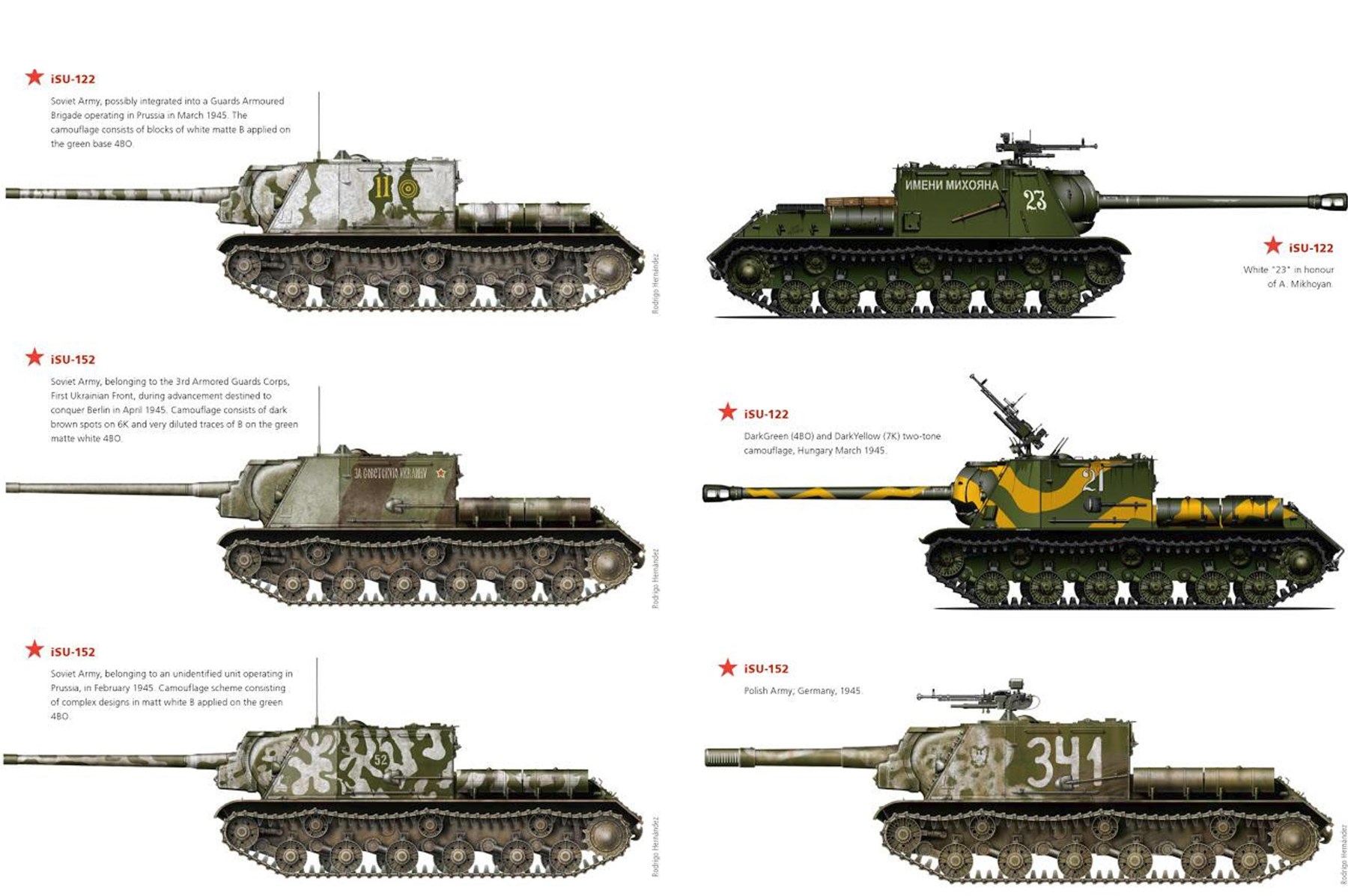
The success of the SU-152, coupled with the development of
the IS (losef Stalin) heavy tank hull, led the NKTP to order design teams at
Chelyabinsk, in cooperation the Mechanized Artillery Bureau (BAS) and General
F. Petrov, to design two new heavy assault guns based on the IS-2 tank’s hull
and chassis. The initial vehicle, designated Object 241, or ISU- 249, was
similar to the SU-152, except for a higher superstructure and more rectangular
with less sloped side armour.
Thicker frontal and side armour (90mm/3.54in compared to
60mm/2.36in on the SU-152) meant that the internal area of both vehicles was
the same, with storage for only 20 rounds each for the 152mm (5.98in) ML-20
howitzer gun. The main difference between the SU-152 and ISU series of vehicles
was a lower suspension and a new, heavy two-piece gun mantlet bolted onto the
right-hand side of the hull. Re-classified as ISU-152, production began at the
end of 1943.
Problems with the availability of the 152mm (5.98in) gun
type because of a lack of available manufacturing capacity in Soviet artillery
factories led to orders to the TsKB-2 team to explore the possibility of
mounting the more abundant 122mm (4.8in) A-19 gun on the ISU hull. This proved
a relatively easy task, because both calibres of gun had the same gun carriage,
meaning that no radical re-design of the hull or vehicle interior was required.
The new assault gun entered service in December 1943 as the ISU-122. In 1944
its firepower was improved with the introduction of the 122mm (4.8in) D-25S gun
designed for the IS-2 tank. This modified design, termed ISU-122-2, also had an
new gun mantlet and improved crew space. In external appearance both gun types
were identical, except for the ISU-152 ‘s shorter gun barrel with a muzzle
brake.
The appearance of the immensely powerful Panzerkampjwagen
Vlb Royal Tiger in fighting south of Warsaw in August 1944 led to a number of
plans to up-gun both types of ISU with the new 122mm (4.8in) BR-7 and 152mm (5.98in)
BR-8 long-barrelled guns, but the realization that the Germans could not deploy
the Royal Tiger in significant numbers caused production of these prototypes to
be abandoned. Another reason was the conclusion of Soviet technicians, based on
combat results, that the IS-2 tank could deal with this new threat.
Post-war changes were made to the final production run of ISU-152Ks by using the IS-2m chassis and the IS-3 engine deck. A total of 4075 ISU-152s were produced during the war, and a further 2450 manufactured between 1945 and 1955, when production ceased. Despite a brief break in manufacture between 1945 and 1947,3130 ISU-122s were produced up to 1952. The chassis of many of these vehicles were adapted for special purposes in the 1960s. The Oka was armed with a 406mm (15.98in) gun designed to fire tactical nuclear shells to break up NATO front-line and reserve units. The ISU mounted the first FROG medium-range missiles, armed with either conventional, chemical, or nuclear warheads. Outside of these special roles in the Warsaw Pact armed forces, the ISU-152 saw service in its original role with the Egyptian Army in the 1967 and 1973 Arab-Israeli wars.
In Service
The ISU-122 and ISU-152 were used in Independent Heavy
Self-Propelled Artillery Regiments, which were awarded the Guards honorific
after December 1944. By the end of the war there were 56 such units. Generally
attached to the tank corps, they were deployed in the second echelon of an
assault, providing long-range direct, and on occasion indirect, fire support to
tanks in the first echelon, targeting German strongpoints and armoured
vehicles. They were also vital in providing defensive antitank and artillery
support for infantry.
| Production history | |
|---|---|
| No. built | 1,150 (all types) |
| Specifications | |
| Mass | 45.5 tonnes (50.2 short tons; 44.8 long tons) |
| Length | 9.85 m (32 ft 4 in) |
| Width | 3.07 m (10 ft 1 in) |
| Height | 2.48 m (8 ft 2 in) |
| Crew | 4 or 5 |
| Armor | front 90 mm (3.5 in) gun shield 120 mm (4.7 in) side 90 mm (3.5 in) |
| Main armament |
A-19S 122 mm gun, with 30 rounds |
| Secondary armament |
12.7 mm DShK AA machine gun, with 250 rounds |
| Engine | 12-cyl. 4-stroke diesel model V-2IS 520 hp (382 kW) |
| Power/weight | 11 hp/tonne |
| Suspension | torsion bar |
| Operational range |
220 km (140 mi) |
| Speed | 37 km/h (23 mph) |